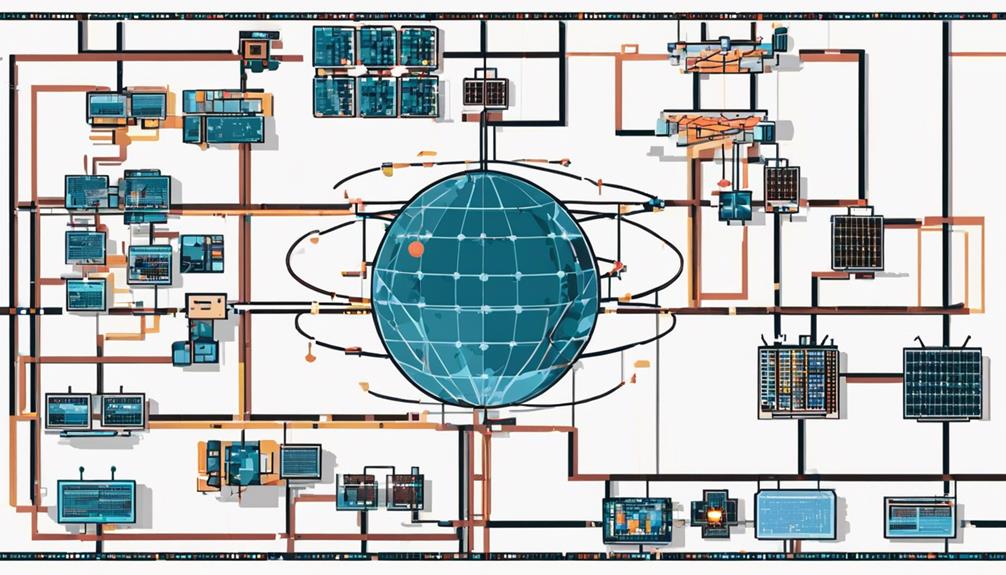Satellite network topologies, integral to the functioning of satellite communications systems, play a crucial role in determining the efficiency and reliability of data transmission. The selection of an appropriate network topology is influenced by factors such as coverage requirements, bandwidth allocation, and network resilience. As we explore the intricacies of star, mesh, and hybrid configurations, the nuances of network performance and scalability come to the forefront, unveiling the complexities that underlie seamless satellite communication. Understanding these topologies is not just a matter of choice but a fundamental aspect of optimizing satellite network operations.
Key Takeaways
- Star, mesh, and hybrid topologies offer diverse communication options for satellite networks.
- Hybrid networks combine star and mesh features for enhanced efficiency and flexibility.
- Complexity and redundancy challenges exist in mesh topology due to multiple interconnections.
- Considerations for selecting a satellite network topology include scalability, costs, and operational impact.
Star Topology Overview

In the context of networking architecture, the Star Topology Overview delineates a configuration where all communication is channeled through a central hub station. In a satellite network utilizing a star topology, the central hub station acts as the focal point for data transmission, managing the flow of information between the hub and remote VSAT (Very Small Aperture Terminal) terminals. Each VSAT terminal establishes a direct line of communication with the central hub station, forming a star-like structure where all network traffic passes through this central point.
The star topology in satellite networks offers several advantages. Firstly, it simplifies network management by centralizing control and routing functions at the hub station. This centralized approach enhances the efficiency of monitoring and troubleshooting network issues as administrators can easily oversee the entire network from one location. Additionally, the star topology is ideal for applications that necessitate centralized data management and control over dispersed remote sites. Industries such as banking, retail, and telecommunication often leverage star topologies in satellite networks to ensure secure and streamlined communication between headquarters and remote branches or terminals.
Mesh Topology Explanation
Utilizing a network architecture characterized by interconnected satellites, the mesh topology establishes a robust and dynamic communication framework. In a meshed network, each satellite is interconnected with every other satellite, enabling multiple data transfer routes and enhancing the network's resilience. Here are key points explaining the mesh topology:
- Efficient Data Transfer: Data transfer in a meshed network occurs through multiple paths, enabling efficient and reliable communication between satellites. This redundancy minimizes the risk of data loss and ensures continuous connectivity.
- Robust Communication: The self-healing design of a mesh network allows for automatic rerouting of data in case of link failures. This feature enhances the network's robustness, making it suitable for mission-critical applications where uninterrupted communication is essential.
- Optimization Techniques: Optimization techniques play a crucial role in determining the most efficient path for data transmission in a mesh network. By analyzing factors such as traffic load and signal strength, these techniques help optimize the network's performance and resource utilization.
- Enhanced Performance: Mesh network topology offers enhanced performance compared to other architectures. The efficient connection paths and robust communication capabilities of a meshed network make it ideal for applications requiring high reliability and low latency.
Hybrid Topology Details

Blending characteristics of both star and mesh configurations, a hybrid network topology combines elements to enhance network flexibility and performance. In this setup, the hub station serves as the central point for data transmission to remote sites, while also allowing direct communication between the remote locations. By integrating these features, hybrid topologies enable efficient data transmission and versatile communication options among various VSAT terminals within the network.
To further illustrate the concept of hybrid network topologies, the table below outlines key aspects of this configuration:
| Aspect | Description | Importance |
|---|---|---|
| Versatility | Offers diverse communication options to cater to different connectivity needs within the network | High |
| Flexibility | Provides increased flexibility in network design, allowing for direct communication between VSAT locations | High |
| Efficiency | Optimizes network efficiency by combining star and mesh characteristics | High |
| Performance | Enhances overall network performance through a balanced integration of different topology features | High |
| Communication Range | Extends communication range by enabling direct links between specific VSAT terminals | Medium |
Hybrid network topologies play a crucial role in modern satellite communication systems, offering a balanced approach that leverages the strengths of both star and mesh configurations to create a robust and efficient network infrastructure.
Advantages of Star Topology
Centralizing communication traffic through a focal hub station characterizes the efficiency and streamlined management benefits of a star network topology. In a star network setup, each satellite terminal, or VSAT, connects directly to the central hub station, ensuring that all data transmission is controlled and monitored from a single point. This arrangement offers several advantages over other network topologies:
- Simplified Management: By concentrating all traffic through the hub station, network administrators can easily monitor and manage data flow, leading to more effective troubleshooting and maintenance procedures.
- Enhanced Access Control: The hub station acts as a gatekeeper, regulating access to the network and ensuring that only authorized VSATs can communicate, enhancing security and data integrity.
- Efficient Data Flow: With the hub station controlling data distribution, communication between different VSATs is optimized, reducing latency and ensuring efficient transmission of information across the network.
- Centralized Control: The central hub station serves as a control center for the entire network, allowing for streamlined decision-making processes and ensuring that data is managed effectively and reliably.
Disadvantages of Mesh Topology

Mesh topology faces drawbacks in terms of scalability, as adding more satellites to the network can be intricate and limited. The complexity of connections in a mesh setup can lead to challenges in maintenance and troubleshooting, requiring meticulous management of links and nodes. Moreover, redundancy issues may arise within a mesh network, impacting routing efficiency and data transmission optimization.
Scalability Concerns in Mesh
The intricate interconnection of numerous nodes in a mesh network often introduces substantial challenges in managing scalability efficiently. In the context of satellite communications, scalability concerns in mesh topologies can significantly impact network performance. Here are some key points to consider:
- Complexity Overload: The overhead of maintaining routing tables and managing connections can overwhelm network administrators.
- Congestion Risks: With an increasing number of nodes, the likelihood of network congestion and inefficient data routing rises.
- Performance Impacts: Scalability issues may lead to decreased network performance and increased latency, particularly during peak usage periods.
- Design Trade-offs: Balancing network complexity and scalability is vital for the successful deployment of efficient mesh network architectures.
Complexity of Connections
Interconnecting multiple nodes in a mesh network results in a compounding of complexities, especially concerning the intricate web of connections present. The decentralized nature of mesh topology in satellite networks poses challenges in managing the network infrastructure efficiently. Routing data through multiple access points, such as Earth Stations, requires sophisticated algorithms to ensure proper data transmission. As the number of nodes increases, scalability becomes a concern, potentially impacting overall network performance. Despite these complexities, mesh networks offer redundancy and resiliency by establishing alternate communication paths. Addressing the intricate interconnections in mesh networks is crucial for maintaining a reliable satellite network infrastructure, although it necessitates careful consideration of routing protocols and network management strategies.
Redundancy Issues in Mesh
Redundancy challenges in mesh network topologies stem from the intricate interconnections between nodes, leading to increased complexities in data routing and network traffic management. Here are some key points to consider:
- Loss of Efficiency: Failures in one node can disrupt multiple interconnected nodes, impacting data transmission efficiency.
- Maintenance Difficulty: Repairing and maintaining redundancy in mesh networks can be challenging, requiring constant monitoring for seamless operation.
- Increased Costs: Redundancy issues in mesh topologies result in higher maintenance and troubleshooting expenses to uphold network reliability.
- Complexity Overload: The abundance of interconnections in mesh networks can overwhelm network administrators, making it harder to manage and troubleshoot issues efficiently.
Implementing Hybrid Network Solutions

Implementing a blend of star and mesh topologies, hybrid network solutions offer a versatile approach to enhancing communication efficiency and network performance. By combining the characteristics of both network topologies, hybrid solutions enable the central hub to efficiently send information to remote sites while also facilitating direct communication between VSAT locations. This dual functionality provides businesses with increased flexibility in network design, allowing them to cater to diverse connectivity needs effectively.
One key advantage of hybrid networks is their ability to integrate star and mesh topologies to ensure efficient data transmission and network resilience. This integration helps optimize communication efficiency by streamlining the flow of information and enhancing network performance through improved reliability and redundancy. Businesses can leverage these benefits to establish robust communication channels that are vital for operations requiring consistent and secure data exchange.
Comparison of Satellite Network Topologies
When evaluating satellite network topologies, it is imperative to consider their distinct characteristics and operational advantages. Different network topologies cater to various connectivity needs, providing flexibility in design. Let's compare some key aspects of satellite network topologies:
- Star Network Topology:
- Routes all data through a central hub station for efficient communication.
- Offers a centralized approach that simplifies network management.
- Ideal for applications where a single point of control is preferred.
- May face challenges in scalability and redundancy.
- Mesh Network Topology:
- Allows for direct communication between VSATs through multiple satellite hops.
- Offers robustness and reliability through redundant paths.
- Suited for scenarios requiring high resilience and dynamic routing.
- Complex to manage due to numerous interconnections.
- Hybrid Network Topology:
- Combines star and mesh configurations to offer versatile communication options.
- Provides a balance between centralized control and decentralized resilience.
- Suitable for diverse requirements, blending efficiency and redundancy.
- Requires careful planning to optimize performance.
- Selection Considerations:
- Satellite constellations impact the topology choice.
- Topology influences reception due to signal routing and interference.
- Operational costs vary based on the network design.
- Scalability and future expansion should align with the chosen topology.
Frequently Asked Questions
Which Topology Is Used in Satellite?
In the realm of satellite communication, various topologies play a crucial role in facilitating data exchange. The choice of topology depends on specific requirements, such as coverage area, data transmission speeds, and network reliability. Each topology, be it star, mesh, or hybrid, offers distinct advantages and disadvantages in the realm of satellite communication. Understanding these differences is essential for optimizing satellite coverage and ensuring seamless communication between ground stations and satellites in orbits like geostationary or low Earth orbit.
What Are the 4 Types of Networks Topology?
When considering network topologies, it is essential to understand the four primary types: star, ring, mesh, and bus configurations. Each has distinct advantages and disadvantages. For instance, mesh networks offer robustness and fault tolerance due to multiple paths, while ring networks can suffer from limited scalability. Implementing a star network involves a central hub connecting all nodes, simplifying management but potentially creating a single point of failure.
What Are the Different Types of Satellite Networks?
In the realm of satellite networks, the different types include star, mesh, fully connected, line, and hybrid configurations. These networks vary in signal strength, orbital patterns, and bandwidth allocation. Each type offers distinct advantages and challenges in terms of communication efficiency, coverage, and scalability. Understanding the nuances of these network topologies is crucial for designing robust satellite communication systems that can meet the diverse requirements of modern applications.
What Are the 7 Types of Topology?
When exploring network topologies, it is essential to understand the seven common types. The star topology features a central hub connecting all devices, ensuring efficient communication. In contrast, the ring topology creates a closed loop for data transmission, enhancing network reliability. Mesh topology stands out for its redundant paths, enabling robust connectivity. Each topology offers distinct advantages, catering to diverse communication requirements in network design.
